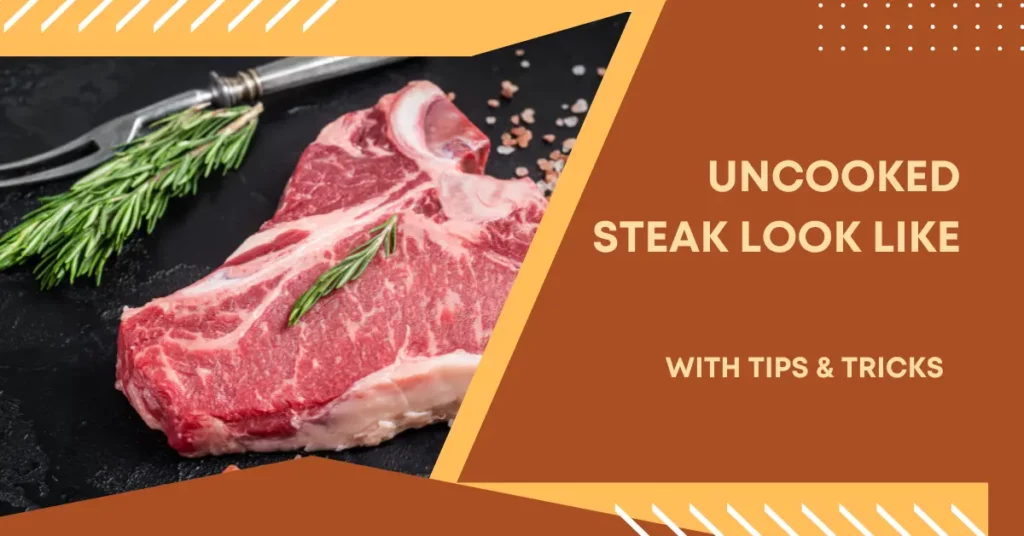This post may contain affiliate links. If you use these links to buy something we may earn a small commission. Thanks.
Steak is one of the most popular cuts of meat worldwide, cherished for its rich flavor and tenderness when cooked properly. However, before it hits the grill or pan, steak has a distinct raw appearance that varies depending on the cut, freshness, and processing. Understanding what uncooked steak looks like can help ensure you select the best quality meat and prepare it correctly. This guide will walk you through the visual and textural characteristics of raw steak, including its color, texture, marbling, and moisture content.
Color of Uncooked Steak
One of the most noticeable characteristics of uncooked steak is its color. The color can indicate freshness, type of cut, and even how the meat has been stored.
Fresh Steak Appearance
- Fresh, high-quality steak typically has a bright red or deep purplish-red hue. This coloration occurs due to myoglobin, a protein found in muscle tissue that reacts with oxygen.
- If a steak has been vacuum-sealed, it may have a slightly darker purple hue due to the lack of oxygen exposure.
Aging and Color Changes
- Dry-aged steaks tend to darken due to dehydration and oxidation, resulting in a deep brown or reddish-brown color.
- Wet-aged steaks, which are stored in vacuum-sealed packaging, may retain a brighter red appearance but can appear slightly darker upon first opening.
Signs of Spoiled Steak
- A grayish-green hue or a slimy surface often indicates spoilage.
- If the steak smells sour or ammonia-like, it’s best to discard it immediately.

Texture of Uncooked Steak
The texture of raw steak is another important factor in determining its quality.
Fresh Steak Texture
- Fresh steak should feel firm yet slightly yielding when pressed.
- The surface should be moist but not excessively wet or sticky.
- Different cuts have varying textures. For example, filet mignon is very tender, while flank steak has a more fibrous structure.
Aging Effect on Texture
- Dry-aged steak tends to be slightly firmer and more concentrated in texture due to moisture loss.
- Wet-aged steak may feel more tender due to the enzymatic breakdown of proteins over time.
Spoiled Steak Texture
- If the steak feels excessively slimy or sticky, it may be going bad.
- A mushy texture or an overly dry surface can indicate improper storage.
Fat Distribution and Marbling
Marbling refers to the white streaks of intramuscular fat distributed throughout the meat. It plays a crucial role in the steak’s flavor and tenderness.
High-Marbling Steaks
- Ribeye and Wagyu steaks are known for their abundant marbling.
- The fat appears as fine white streaks or specks evenly distributed throughout the muscle fibers.
- More marbling generally results in a juicier, more flavorful steak when cooked.
Leaner Steaks
- Filet mignon, sirloin, and top round steaks contain less marbling.
- They appear more uniform in color with fewer visible fat streaks.
- Leaner cuts tend to be firmer and require careful cooking to avoid dryness.
Marbling and Meat Quality
- USDA Prime beef has the highest level of marbling, followed by USDA Choice and Select.
- Wagyu and Kobe beef are known for their extreme marbling, giving them a distinct appearance and buttery texture.
Bone-In vs. Boneless Appearance
Some steaks come with bones, which can impact their appearance and cooking properties.
Bone-In Steaks
- Examples include T-bone, Tomahawk, and Porterhouse steaks.
- The exposed bone may have some red marrow visible.
- Bone-in steaks often retain more moisture and flavor when cooked.
Boneless Steaks
- New York strip, filet mignon, and sirloin steaks are commonly sold without bones.
- They have a more uniform shape and thickness.
- Boneless steaks are easier to cook evenly compared to bone-in cuts.
Moisture and Juices in Uncooked Steak
Moisture content can affect both the appearance and cooking process of steak.
Fresh Steak Moisture Content
- A fresh steak should have a slightly wet surface due to natural juices.
- It should not be excessively dry or too watery.
Vacuum-Sealed Steak
- Some vacuum-sealed steaks may release liquid upon opening, known as “purge.”
- This is normal and does not indicate spoilage unless the liquid has a foul odor.
Signs of Excess Moisture or Dryness
- If a steak is excessively wet and mushy, it may have been stored improperly.
- If it appears too dry or shriveled, it may have been exposed to air for too long, leading to dehydration.
Variations by Cut and Type
Different types of steak cuts and sources can influence the appearance of raw meat.
Common Beef Steak Cuts
- Ribeye: High marbling, rich red color with white streaks of fat.
- Filet Mignon: Deep red, lean, and fine-grained.
- New York Strip: Moderate marbling with a consistent deep red color.
- Flank Steak: Darker red with visible muscle fibers and little marbling.
Specialty Steak Types
- Dry-Aged Steak: Darker, firmer, and has a slightly crusted exterior.
- Wagyu Steak: Extremely high marbling, almost pinkish due to the fat distribution.
- Grass-Fed vs. Grain-Fed: Grass-fed steak is often leaner and darker in color, while grain-fed steak has more marbling and a lighter red hue.
Game Meat Steaks
- Venison: Deep red, almost purple, with very little fat.
- Bison: Darker red than beef, typically leaner with less marbling.
Conclusion
Understanding what uncooked steak looks like is essential for selecting, storing, and preparing high-quality meat. Fresh steak should have a bright red to deep purplish-red color, a firm yet slightly yielding texture, and adequate marbling depending on the cut. Avoid steaks with a slimy texture, excessive discoloration, or an unpleasant odor, as these are signs of spoilage. Whether you prefer a marbled ribeye or a lean filet mignon, knowing how to identify a good cut of raw steak will enhance your cooking experience and lead to better-tasting meals.
